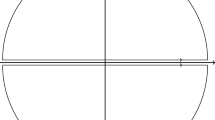Abstract
We study the semiclassical mechanics of systems with second-class constraints. We assume that the quantum mechanics of such a system is constructed by the Batalin–Fradkin–Tyutin method, where some additional coordinates and momenta are introduced and second-class constraints are converted into firstclass constraints. We also assume that the algebraic quantization method is used to quantize the extended system. To construct the semiclassical approximation, we use the Maslov complex germ theory. We study the semiclassical states of a system with second-class constraints, their scalar product, and the action of semiclassical observables in the first order of the semiclassical expansion. We consider the transformation of semiclassical states in the course of evolution.
Similar content being viewed by others
References
V. P. Maslov, Theory of Perturbations and Asymptotic Methods [in Russian], Moscow State University, Moscow (1965).
V. P. Maslov, Operator Methods [in Russian], Nauka, Moscow (1973); English transl.: Operational Methods, Mir, Moscow (1976).
V. P. Maslov, The Complex WKB Method for Nonlinear Equations [in Russian], Nauka, Moscow (1977); English transl. (Progr. Phys., vol. 16), Birkhäuser, Basel (1994).
R. Jackiw, Rev. Modern Phys., 49, 681–706 (1977).
M. V. Karasev and V. P. Maslov, Nonlinear Poisson Brackets: Geometry and Quantization [in Russian], Nauka, Moscow (1991); English transl. (Transl. Math. Monogr., vol. 119), Amer. Math. Soc., Providence, R. I. (1993).
V. P. Maslov and O. Yu. Shvedov, Complex Germ Method in Many-Particle Problems and Quantum Field Theory [in Russian], Editorial URSS, Moscow (2000).
P. A. M. Dirac, Lectures on Quantum Mechanics (Belfer Grad. School Sci. Monogr. Series, vol. 2), Belfer Graduate School of Science, New York (1964).
D. M. Gitman and I. V. Tyutin, Canonical Quantization of Fields with Constraints [in Russian], Nauka, Moscow (1986).
O. Yu. Shvedov, Theor. Math. Phys., 136, 1258–1272 (2003).
I. A. Batalin and E. S. Fradkin, Phys. Lett. B, 180, 157–162 (1986).
I. A. Batalin and E. S. Fradkin, Nucl. Phys. B, 279, 514–528 (1987).
I. A. Batalin and I. V. Tyutin, Internat. J. Mod. Phys. A, 6, 3255–3282 (1991).
N. Banerjee, R. Banerjee, and S. Ghosh, Ann. Phys., 241, 237–257 (1995); arXiv:hep-th/9403069v1 (1994).
O. Yu. Shvedov, “Semiclassical mechanics of constrained systems,” arXiv:hep-th/0111265v1 (2001).
O. Yu. Shvedov, Math. Notes, 65, 365–380 (1999).
O. Yu. Shvedov, Sb. Math., 190, 1523–1557 (1999).
Author information
Authors and Affiliations
Additional information
__________
Translated from Teoreticheskaya i Matematicheskaya Fizika, Vol. 186, No. 3, pp. 423–432, March, 2016.
Rights and permissions
About this article
Cite this article
Shvedov, O.Y. Maslov complex germ method for systems with second-class constraints. Theor Math Phys 186, 365–373 (2016). https://doi.org/10.1134/S0040577916030053
Received:
Published:
Issue Date:
DOI: https://doi.org/10.1134/S0040577916030053



